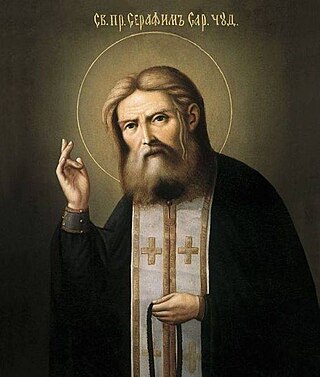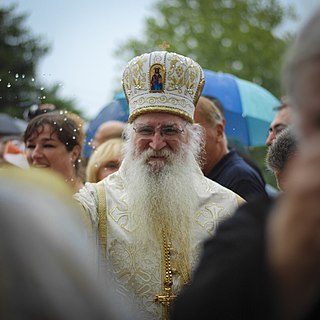
Voronezh is a city and the administrative centre of Voronezh Oblast in southwestern Russia straddling the Voronezh River, located 12 kilometers (7.5 mi) from where it flows into the Don River. The city sits on the Southeastern Railway, which connects western Russia with the Urals and Siberia, the Caucasus and Ukraine, and the M4 highway (Moscow–Voronezh–Rostov-on-Don–Novorossiysk). In recent years the city has experienced rapid population growth, rising in 2021 to 1,057,681, up from 889,680 recorded in the 2010 Census, making it the 14th-most populous city in the country.

September 3 - Eastern Orthodox liturgical calendar - September 5

May 13 - Eastern Orthodox Church calendar - May 15

June 3 - Eastern Orthodox Church calendar - June 5

Seraphim of Sarov, born Prókhor Isídorovich Moshnín (Mashnín) [Про́хор Иси́дорович Мошни́н (Машни́н)], is one of the most renowned Russian saints and is venerated in the Eastern Orthodox Church and the Anglican Communion. He is generally considered the greatest of the 18th-century startsy (elders). Seraphim extended the monastic teachings of contemplation, theoria and self-denial to the layperson. He taught that the purpose of the Christian life was to receive the Holy Spirit. Perhaps his most popular quotation amongst his devotees is "Acquire the Spirit of Peace, and thousands around you will be saved."

June 22 - Eastern Orthodox Church calendar - June 24

August 6 - Eastern Orthodox liturgical calendar - August 8

Demetrius of Rostov was a leading opponent of the Caesaropapist reform of the Russian Orthodox church promoted by Theophan Prokopovich. He is representative of the strong Cossack Baroque influence upon the Russian Orthodox Church at the turn of the 17th and 18th centuries.

February 11 - Eastern Orthodox liturgical calendar - February 13

Mitrofan Ban was Bishop of Cetinje, Metropolitan of Montenegro, and exarch of the Serbian Orthodox Church. He was also Archimandrite of the Cetinje monastery. He presided over the Holy Bishopric Synod (1919-1920) that unified the Serbian Orthodox Church in 1920.

November 22 - Eastern Orthodox liturgical calendar - November 24

Mitrofan (Mitrophan) Yefimovich Pyatnitsky was a Russian and Soviet musician, gatherer of Russian folk songs. He established the famous Pyatnitsky Choir in 1910 from 18 peasants originally from the Voronezh, Ryazan and Smolensk gubernias. After his death, the chorus was named after him.
Mitrofan is a Slavic name derived from Greek Μητροφάνης : μήτηρ "mother + φαίνω, "appear, shine". Its English equivalent is Metrophanes.

Archbishop George is bishop of the Russian Orthodox Church Outside of Russia, bishop of Sydney, Australia and New Zealand, and former abbot of the Holy Cross Monastery in Wayne, West Virginia.

The Diocese of Voronezh is an eparchy of the Russian Orthodox Church with its center in the city of Voronezh. It Combines parishes and monasteries in the Voronezh Oblast. The diocese is headed by Metropolitan Sergius (Fomin). The official holiday is on August 28.

Mitrofan Kodić is a Serbian Orthodox bishop who has served as the head of the Serbian Orthodox Eparchy of Canada since 2016. He was formerly the Bishop of the Eastern American Eparchy.

Athanasius III Patellarios was the Patriarch of Constantinople in 1634, 1635 and 1652. Before his patriarchate Athanasius was metropolitan of Thessaloniki. He participated at Patriarch Nikon's book editing reforms in 1653.

The Holy Trinity Cathedral of the Alexander Nevsky Lavra is a Russian Orthodox cathedral in Saint Petersburg. It is in the Diocese of Saint Petersburg and part of the Alexander Nevsky Lavra, where it is the cathedral church of the monastery complex.

The Annunciation Church of the Alexander Nevsky Lavra, or in full, the Church of the Blessing of the Most Holy Virgin and the Holy Blessed Prince Alexander Nevsky is a Russian Orthodox church in Saint Petersburg. It is in the Diocese of Saint Petersburg and is part of the Alexander Nevsky Lavra.

Mitrofan Borisovich Grekov was a Russian and Soviet painter, considered to be the "father of Soviet battle painting".














